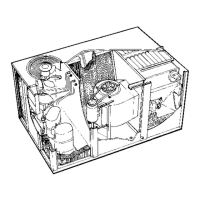Page 29
stage operation begins. When K19 contacts open (2nd
stage demand stops) time delay DL3 is de-energized and
reset immediately. When DL3 resets, the 2nd stage opera
tor of the gas valve is de-energized and closed.
10-Blower Delay Relay K25
A heat type combination blower delay / relay (K25) located
in the heating controls box is used to coordinate blower op
eration with burner operation. K25 is a SPDT relay which
closes 40+10 seconds after being energized and opens
110+20 seconds after being de-energized.
11-Burner Ignition Controls A3, A12
All models use direct spark, multiple try ignition. Units using a
single heat exchanger are equipped with a single ignition
control, spark and flame sensor (A3). Units equipped with
dual heat exchangers are equipped with separate ignition
controls, spark electrodes and flame sensors (A3first stage,
A12second stage).
The ignition control is located in the heating control box. On
a heating demand, the ignition control is energized after
combustion air blower prove switch closes. The ignition
control then allows 30 to 40 seconds for the combustion air
blower to vent exhaust gases from the burners. At the end
of the delay the ignition control activates the first stage op
erator of the gas valve (W1), the spark electrode, the flame
sensing electrode and blower relay (and status panel no
heat relay K29 - if so equipped). Sparking stops after flame
is sensed. The combustion air blower continues to operate
throughout the heating demand. If the flame fails or if the
burners do not ignite, the ignition control will attempt to ig
nite the burners up to two more times. If ignition cannot be
obtained after the third attempt the control will lock out. The
ignition control is not adjustable.
WARNING
SHOCK HAZARD. SPARK RELATED COM
PONENTS CONTAIN HIGH VOLTAGE WHICH CAN
CAUSE PERSONAL INJURY OR DEATH. DISCON
NECT POWER BEFORE SERVICING. CONTROL IS
NOT FIELD REPAIRABLE. UNSAFE OPERATION
WILL RESULT. IF THE CONTROL IS INOPERABLE,
SIMPLY REPLACE THE ENTIRE CONTROL.
a- Electronic direct spark ignition with flame rectifica
tion sensing is used on all GCS16 units. Flame sig
nal strength ranges from 8 to 20 microamps. All
units have controls manufactured by Fenwal.
FIGURE 20
SPARK
HIGH VOLTAGE
POWER (24VAC INPUT)
TO GAS VALVE
(24VAC OUTPUT)
TO FLAME SENSOR
GROUND
TOP VIEW
FENWAL IGNITION CONTROL
b- The Fenwal control is illustrated in figure 20. The
fourwire harness, plugged directly into a jack on
the side of the control, is used to connect control to
unit. Each of the four jack terminals is identified by
function. The spark electrode wire connects to the
spark plugtype connector on top of the control.
c- The ignition control provides three main functions:
gas valve control, ignition and flame sensing. It is
powered only after the combustion air prove
switch has closed. The ignition attempt sequence
provides three trials for ignition before locking out.
The blower control (K25) is energized simulta
neously with the gas valve, so the blower will ener
gize 30 to 45 seconds after flame has successfully
been established. The unit will usually ignite on the
first attempt. See figure 21 for a normal ignition se
quence with nominal timings for simplicity.
d- Proper gas/air mixture is required for ignition on
the first attempt. If there is any deviation, within tol
erance of the unit, a second or third trial may be
necessary for ignition. The control will lock out the
heating system if ignition is not obtained within
three trials and the (indoor) blower will not start.
Reset after lockout requires only breaking and re
making thermostat demand. See figure 22 for the
ignition attempt sequence with retrials (minimal
timings given for simplicity). Loss of flame during a
heating cycle is indicated by an absence of flame
signal (0 microamps). If this happens, the control
will immediately restart the ignition sequence and
then lock out if ignition is not gained after the third
trial.
e- Specific timings for the Fenwal control are shown
in figure 23.

